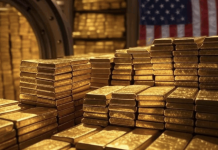Returning To A Gold Standard
Every country, including the U.S., must maintain monetary discipline to sustain a healthy economy. Returning to a gold standard could lead to economic stability by instilling fiscal discipline and restoring the spiritual integrity that once underpinned America’s greatness.
And yes, that’s a pretty bold statement. After all, you could argue that gold, like paper money, is used to pursue material gains. Indeed, there’s probably no place on earth that wouldn’t accept gold as a currency in exchange for material goods. Gold’s monetary and spiritual history stretches back at least 5,000 years.
Gold is more than just another means of exchange; it’s a sacred metal affiliated with religious reverence. Here’s a revealing quote from Charlotte Behr of the University of Roehampton in an article published by a volunteer archaeological program managed by the U.K. government:
“Gold has long been associated with a divine sphere in pre-Christian and Christian religion. Its shine, indestructible nature, malleability, and relative scarcity made it an ideal material for embodying divine qualities and expressing human veneration of the divine. Gold was perceived as an appropriate material with which to address the gods (Elbern 1988).”
“Temples, sanctuaries, and churches were decorated lavishly with golden or gilded statues and images. Liturgical equipment was made out of gold (La Niece 2009).”
“The gods of Germanic myths lived, according to the Völuspa, in a hall covered in gold and played with golden board games (Pálsson 1996, stanzas 60 and 61).”
“Janes, in his book God and Gold in Late Antiquity, has shown the continuity of the use of gold and its numerous associations with the numinous, from a pre-Christian to a Christian world. Gold retained its importance even within a religion that upheld poverty and the rejection of worldly goods (Janes 1998). Liturgical vessels, reliquaries, crosses, objects needed for performances of sacred rituals were made in gold. There is also a long tradition of votive offerings, for example in the shape of tablets that were made in precious metals, gold or silver, and dedicated to a divinity; again, we see continuity from pre-Christian to Christian customs. The close association of gold and the divine, the gods, can thus be observed in many different aspects, even if a precise definition of how this link worked and what it meant remains difficult.”
Gold’s association with the divine is likely why gold is the only metal prized more for its beauty than its material uses. Gold’s intrinsic beauty has a sacred quality. Simone Weil, the great French mid-20th-century religious philosopher, wrote that once gold left the French monetary system, those who sought to accumulate money were also “desirous of power.” In other words, money becomes a source of control over others if it is absent from a connection to gold. Likewise, the accumulation of money tethered to gold is tantamount to accumulating something sacred. However, using the sacred as a source of power and control over others would be akin to blasphemy.
Unique Properties of Gold
Moreover, not only has gold has long been associated with the divine, but its unique qualities constitute an argument for the existence of the divine. Part of gold’s everlasting beauty comes from the fact that, because gold doesn’t combine with oxygen, it doesn’t tarnish. This is one reason that gold has an inherent natural luster, which is related to why the metal is universally regarded as beautiful.
Another unique property of gold is that it is virtually indestructible. Although acids can dissolve gold, a metallurgist can recover the precious metal to its original state. During World War II, the French dissolved Olympic gold medals into an acid bath to hide them from enemies. After the war, the gold was recovered using a special chemical process and refashioned into Olympic medals. Melted or not, gold remains gold. By contrast, when you melt virtually any other metal, some molecules are lost and combine with oxygen to make a new molecule.
Gold’s indestructibility means that all the gold that has ever been mined still exists somewhere on the planet. Gold also is the world’s most malleable and ductile metal. Both properties relate to how flexible gold is. That’s important because many religions have used gold to create objects honoring the divine. A metal’s malleability refers to how easily it can be shaped, and one measure of this is how thin you can make a metal. Gold’s potential thinness can be measured in atoms – so thin as to be transparent. Gold that’s so thin that it would take 10,000 sheets to constitute a millimeter would still be thick enough to make gold’s intrinsic beauty apparent. An ounce of gold this thin could cover about 900 square feet. Ductility is measured in terms of how far something can be stretched. For gold, one ounce could be stretched 50 miles, leaving it with a thickness equivalent to about 20 atoms. A moment’s thought suggests that gold’s natural beauty, malleability, and evidence that it lasts forever make it the ideal divine metal.
Gold is used only sparingly in industry. While its unique properties would make it widely applicable in many industrial applications, the same properties make gold an ideal store of value. Gold is currently the only non-paper reserve asset. Ask yourself, how could anything be better suited than gold to back a monetary system than something that cannot be destroyed and has an unlimited lifetime? These qualities are universally viewed as sacred and can serve to limit the corrupting influence of money. Remember, in the biblical book of Timothy, there is a warning that “the love of money is the root of all evil.” No one would deny that money is necessary for commerce and worldwide progress. However, if money is imbued with a sacred quality, it is much more likely to ensure that progress will be made for the benefit of all.
The Existence of Proton 79
Also true is that you can’t determine how gold was created in our solar system. Scientists have postulated that gold could result from a nuclear reaction in a very dense neutron star. Still, that theory has been widely rejected in the scientific community because the reactions in a massively dense star would not be sufficiently energetic—hot—to create gold or other heavy metals such as the platinum group metals (PGMs).
That leaves scientists looking for particular events that generate uniquely massive amounts of heat and energy, such as the collision of two neutron stars or two black holes. While the colossal amounts of energy generated by such events could produce heavy and dense metals, their rarity makes it seem unlikely they could account for all the gold and PGMs on this planet. In addition to the rarity of the extraordinary celestial events that could quantify the existence of gold on Earth, you’d still need to explain how it ended up with all the unique properties that distinguish it from other metals.
Chemically, elements are defined by the number of protons in their nucleus, which equals the number of electrons that orbit the nucleus. Gold’s nucleus has 79 protons, which leads chemists to say that, theoretically, you could make gold by eliminating one proton from mercury or adding one to platinum. Apart from the practical difficulties of attempting to add or remove one proton – it would require engineering several nuclear reactions that are beyond current capabilities or far too expensive to consider. Plus, you’d need to ensure you don’t accidentally create a radioactive version of the element. However, even if you could develop reactions satisfying all these constraints, you might end up with something like gold, but it would likely lack malleability and ductility. That’s because some of gold’s unique properties don’t simply result from gold having a particular number of protons, neutrons, and electrons.
The Mystery of the Electron Sea
Many attempts have been made to explain the chemistry of gold. The most speculative theory likely comes from a physical model initially introduced by one of the founders of quantum mechanics, Paul Dirac. This model is known as the “electron sea,” which, among other things, implies the existence of negative energy.
The electron sea’s existence could be seen as densely packed atoms moving past one another quickly. Therefore, an electron sea could account for gold’s malleability and ductility, although it wouldn’t be nearly as great, meaning its special role as a sacred metal probably would not exist. In other words, without the existence of an electron sea, gold would not be gold. This means that even if the universe contains enough highly energetic events necessary to create gold in quantities that can be found on our planet – such as the collision of two neutron stars – there would still not be enough evidence to say the metal produced in these reactions would have all the properties of gold.
I am unduly fascinated with the electron sea, which predicted that every elementary particle has an antiparticle. My fascination stems from a statement made by an article published in 2023 in the peer-reviewed journal, the International Journal of Physics, which suggests that the current model of quantum mechanics – the so-called Copenhagen Interpretation – is probably not consistent with the notion of an electron sea.
Instead, another model associated with David Bohm and Louis de Broglie would work better. This grabbed my attention. While consistent experimentally with the Copenhagen interpretations, David Bohm’s view of physics differs widely in its underlying metaphysics and ontology. The late Martin Gardner, one of the best-known mathematical communicators who edited a column on mathematical puzzles in Scientific American for many years, argued that Bohm’s model bordered on panpsychism. This theory purports that consciousness is a fundamental property of the universe, i.e., inherent in every particle, including electrons and protons, and not unique to human beings. That was back in 1959. Today, panpsychism is regarded by many philosophers, such as Thomas Nagel, as a plausible candidate for understanding the universe.
Bohm viewed his metaphysics as consistent with the existence of the paranormal or higher power. Interestingly, although Bohm and Dirac worked in London simultaneously, there is no indication they ever discussed physics. Still, there have been papers written attempting to tie the thinking of these two great physicists. If it’s true that gold is more consistent with the Bohm view, so are the foundations of today’s physics, which become evidence of the existence of a higher power of the divine. The Copenhagen Interpretation of quantum phenomena, which is associated with Neil Bohr, is not more agnostic than the one proposed by Bohm and de Broglie. While Bohr deals with waves and probabilities, Bohm deals with a causal model involving particles.
While it could be evidence that gold is somehow associated with the divine, the potential connection between Dirac’s electron sea, Bohm, and gold needs substantial support to be characterized as more than an intriguing theory. The explanation with the highest support from theoretical chemists, such as the distinguished Spanish theoretical chemist M. Concepción Gimeno, argues that Einstein’s special theory of relativity is the primary reason for many of gold’s unique properties. However, there are serious problems with this theory; even if it’s correct, it raises questions that make a case for intelligent design. Einstein’s well-known special relativity involves relationships constrained by a strict limit to the maximum speed of light, which implies the assumption that the laws of physics remain constant regardless of how fast you travel.
Most importantly, no matter how fast you travel relative to another stationary observer, both measure the speed of light as traveling at the same speed. This was Einstein’s first theory and predicted, among other things, time dilation – the well-known phenomenon that if one identical twin travels close to light speed relative to his stationary twin, the fast-flying twin will age slower than their identical twin. A related consequence of the theory is that the mass of an object, including particles such as electrons, will increase as its orbital speed approaches the speed of light.
Gold: The Most Noble Metal
Gold has the highest atomic number among noble metals (79). Its nucleus contains the highest number of protons, which translates into electrons within the innermost shell having the greatest mass when orbiting relative to their stationary mass; theoretical chemists refer to the ratio of relativistic mass to stationary mass. This ratio is deemed the primary reason that gold’s malleability, ductility, luster, nobility, and eternal life expectancy far exceed other noble metals.
Regardless of the evidence presented for the importance of the relativistic to standing ratio, it needs to be revised. The chemical properties of gold are not merely inherently different than those of other metals; there is a quantum leap in the difference, much more than the difference of one proton. If you look at a table of noble metals, gold is at the top by levels inconsistent with a single proton difference. Chemists use three measures of reactivity: standard reduction potential, electronegativity, and electron affinity. In all measures, gold is first and platinum second (actually tied for second in electronegativity).
Moreover, gold is the most reliable of these three standard reduction potentials; on that measure, it’s 25% less reactive. The difference between the other two measures is about 10%. Minimal differences in the relativity ratios do not easily explain these sizable differences in nobility. Theoretically, it’s possible to define gold’s color and luster by those differences, but the chemical measures of its nobility suggest another factor is at play.
As mentioned above, the atomic number of gold is 1 unit higher than platinum, meaning one additional proton and electron. The extra proton accounts for the relativistic differences between the two elements. But what about the additional electron? That difference, in many ways, is more significant. The outer shell of platinum has 5 electrons compared to 6 for the comparable shell in gold. The outer shells are not affected by extra protons, but the extra electron in the gold shell is the ideal number for the overall stability of the atom. And that is a primary culprit in the differences. While there is no evidence that gold has ever been destroyed, in the example mentioned above, where gold was dissolved in aqua regia acid and then later wholly recovered, allowing Olympic medals to be recreated would not have been possible if the medals had been made from platinum. In addition, platinum will react with oxygen and tarnish at high temperatures, which does not happen with gold. In other words, just one infinitesimally small particle, which in the world of some versions of quantum mechanics (Bohm’s) does not exist as a particle but rather as a wave, determines whether something has an indefinite lifetime or will disintegrate over time. The everlasting nobility of gold quantifies its affinity with the divine realm while also being a peerless store of value. At least to me, that feels like the interplay of a higher power.
Coincidence Obeys No Laws
In total transparency, I don’t practice any particular religion, but I consider myself spiritual, and I’ve had several spiritual experiences throughout my life. One of these spiritual experiences concerned the topic of gold. Around 35 years ago, I was writing a chapter on investment hedging for a book. At the time, I knew next to nothing about investing in gold and, in those pre-Google days, was desperate to find something to say that wasn’t a cliché.
After writing for many hours, I took a break and walked to the end of my driveway to check the mailbox. The latest edition of Nature magazine had arrived, and the cover story featured gold on the cover! I believe it was highly auspicious that if not for my burning desire to find something new on gold, I probably wouldn’t have paid much attention to the article, which, to the best of my knowledge, is the only time any metal has been featured on the cover of Nature magazine. Finding that article at that moment affected how I think about gold and how I feel about everything related, including the importance of spirituality to a country’s well-being.
Some people may view coincidences as trivial. But others see them as windows into the sacred, a sign of humanity amid seemingly senseless chaos. The following quote from the book 2666 by the Chilean novelist Roberto Bolaño has stayed with me for nearly 20 years:
“Coincidence obeys no laws, and if it does, we don’t know what they are. Coincidence, if you’ll permit me the simile, is like the manifestation of God at every moment on our planet. A senseless God making senseless gestures at his senseless creatures. In that hurricane, in that osseous implosion, we find communion. The communion of coincidence and effect and the communion of effect with us.”
For Bolaño, the choice is to view the world as an endless quagmire or something imbued with transcendent spirituality.
Is it a coincidence that when America left the gold standard, the country’s unity & spirituality eroded, and the U.S. became, as I see it, a soulless wasteland? I don’t think so.
Gold’s specialness, its characteristics that science can’t explain, its role in the world’s religions, its universal appeal as an object of beauty, and its global acceptance as currency distinguish it as inherently material and spiritual. Furthermore, one may ponder whether it’s coincidental that one extra electron in an outer shell is the difference between the divine and the mundane. Gold’s one extra electron is a countless example that compels us to accept some form of intelligent design and reject the apotheosis of science.
In closing, let’s return to Dirac, who some consider at least on a par with the most outstanding physicists ever. In his mid-20s, Dirac was quoted as saying that science was sufficient for understanding all the laws of the universe, while the idea of God was unnecessary. Moreover, he added that the notion of a higher power was likely born from primitive people who had no explanations for nature’s harmful vagaries. On the contrary, three decades later, in an article Dirac wrote in Scientific American, he stated:
“It seems to be one of the fundamental features of nature that fundamental physical laws are described in terms of a mathematical theory of incredible beauty and power, needing quite a high standard of mathematics to understand it. You may wonder: Why is nature constructed along these lines? One can only answer that our present knowledge shows that nature is so constructed. We simply have to accept it. One could perhaps describe the situation by saying that God is a mathematician of a very high order, and He used very advanced mathematics in constructing the universe. Our feeble attempts at mathematics enable us to understand the universe better.”
A primary goal of my work is to convince you that the more mature Dirac was right. One consequence is the intelligent design of gold, which should compel us to elevate gold to its rightful place as the only monetary center that can combine the necessity of using a currency to build a better material society while avoiding the pitfalls so evident in today’s America, where the powers that lead us have fallen prey to the compelling lure to worship money, which inherently destroys our humanity, and disconnects us from the divine. It undermines humanity’s natural inheritance, which is the opportunity to evolve and create a better society for everyone on the planet.















